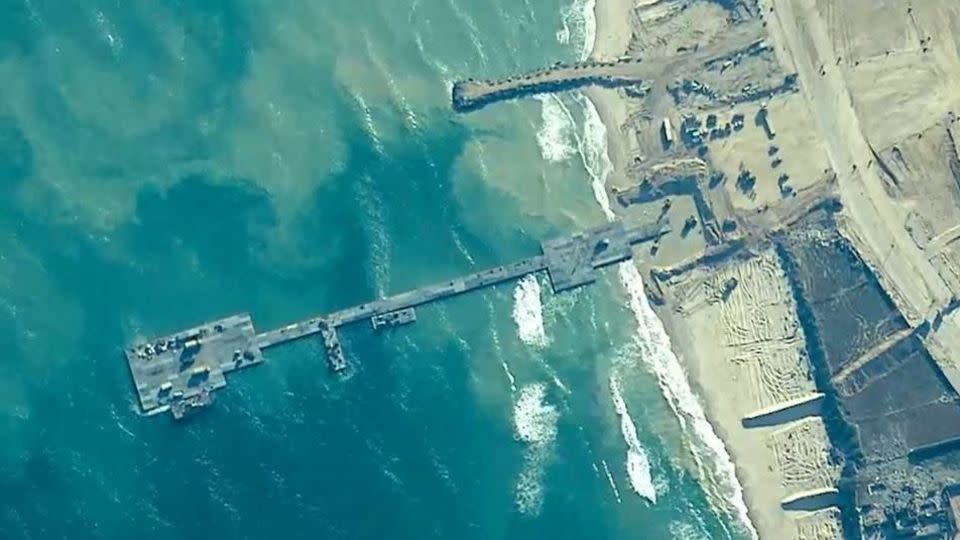US military starts delivering aid to Gaza through floating pier. Here’s what we know
Trucks carrying humanitarian aid into Gaza have begun moving ashore after arriving through the floating pier built by the US military, according to the US Central Command (CENTCOM).
The pier was anchored to a beach in Gaza on Thursday and will be used to funnel aid from various countries into the besieged strip, with most border crossings to the enclave closed and a catastrophic humanitarian disaster unfolding inside.
No US troops went ashore in Gaza, according to CENTCOM.
The goal is to get about 500 tons of humanitarian assistance into Gaza through the pier daily, according to Adm. Brad Cooper, the commander of CENTCOM. That means about 90 trucks worth of aid a day, and the goal is to build up to 150 trucks a day.
Over 300 pallets of humanitarian aid were delivered to Gaza through a new floating pier installed by the US military, according to a statement from Israel Defense Forces (IDF) on Saturday.
On Friday, the UN humanitarian agency, OCHA, said Gaza was facing a “dire” food situation with barely more than 300 aid trucks entering the strip since Israel began its offensive in Rafah.
The maritime corridor is coming at a critical moment – with the Rafah border crossing to Gaza having been closed for more than a week, preventing aid from getting through. That crossing was the only one between Gaza and Egypt – with all other border points in the strip controlled by Israel.
Here’s what we know about the new aid route:
How was the pier built and how will it work?
The US began building the floating pier in late April at a cost of $320 million and with the help of some 1,000 US soldiers and sailors. The US said that it is only a temporary measure that is “entirely humanitarian in nature.”
Pieces for the pier were loaded aboard ships on the East Coast of the US and then “transported 6,000 miles across the ocean,” according to CENTCOM’s Cooper. The pieces were assembled off the coast of Gaza, with final assembly taking place in the Israeli port of Ashdod.
The aid delivered via the pier will go through several steps before reaching Gaza. It will arrive in Cyprus by either air or sea where it will be screened by the US and Israel and palletized before being brought by ship to a floating platform near the Gaza coast. Then it is finally transported to the floating pier and loaded onto trucks to distribute on land.
The US has said the pier is not meant to replace aid that enters through land crossings, which aid workers have said are the fastest and easiest way to get relief into the territory.
“This maritime route is additive and is not meant to replace land routes into Gaza,” Cooper said.
The UN’s World Food Programme will be responsible for receiving and distributing the aid in Gaza.
Why is aid being shipped this way?
Most land crossings into Gaza remain either shut or congested due to lengthy inspections by Israel. That has led the US and other countries to start air-dropping aid into Gaza, which human rights organizations have criticized as insufficient.
The UN has warned of famine setting in in parts of Gaza, calling on Israel to open more land crossings for aid. USAID Administrator Samantha Power, the top US humanitarian official, has also assessed it is “credible” that famine is already occurring in parts of Gaza.
In March, the first batch of humanitarian aid by sea was delivered in an operation separate from the US pier project.
Today, only the Israeli-controlled Kerem Shalom crossing and the “Western Erez” Crossing in northern Gaza are open, although the amount of aid trickling through them is nowhere close to what Gaza needs.
The UN’s World Food Programme however says that since May 6, when Israel launched its Rafah operation, the organization has been unable to access and receive aid from the Kerem Shalom crossing. The United Nations Relief and Works Agency for Palestine Refugees (UNRWA) said the crossing was closed between May 6-10.
The Rafah crossing with Egypt, the entry point for nearly a quarter of all aid into Gaza, was also closed last week after Israel seized it as part of a ground offensive into the city, and is yet to reopen.

How much aid is getting into Gaza now?
The US State Department has said that “not nearly enough” trucks are getting into Gaza.
The UN estimates that 500 trucks are needed per day to alleviate the suffering of Gazans, but on May 11, UN figures showed that only six trucks entered. No data is available after that date.
The UN agency stressed that more aid should be allowed to pass through checkpoints and enter Gaza by land. “Any and all aid into Gaza is welcome by any route. However, getting aid to people in need, into and across Gaza, cannot and should not depend on a floating dock,” OCHA spokesperson Jens Laerke said Friday.
Israel however said on Friday that “aid is flowing into Gaza by land, sea, and air” and through “multiple aid routes.”
The Coordinator of Government Activities in the Territories (COGAT), the Israeli body that coordinates the flow of aid into the strip, said that 365 trucks “were transferred” to Gaza Thursday.
The UN’s OCHA on Thursday said that crossings into Gaza have either been closed, are unsafe to access or not logistically viable.
“Aid distribution is almost impossible with no regular fuel imports, unstable telecommunication and ongoing fighting,” OCHA said on X. “The impact is devastating for over 2 million people.”
CNN’s Kareem Khadder and Sarah El Sirgany in Jerusalem contributed reporting.
For more CNN news and newsletters create an account at CNN.com


